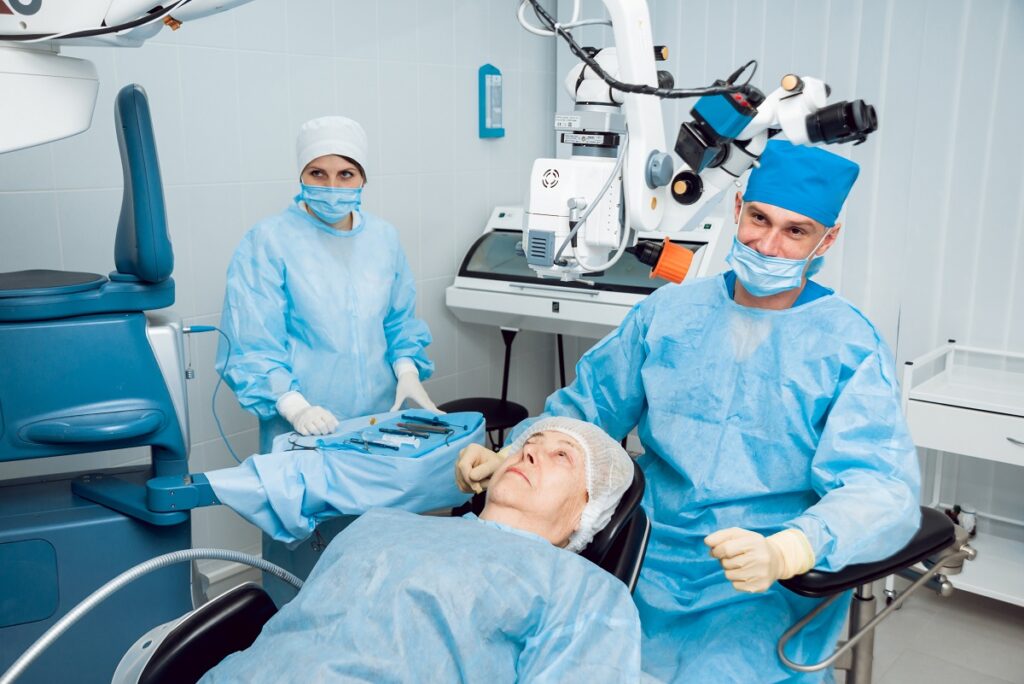Cataracts are normally caused by aging yet can occur in younger people sooner from an eye injury, diabetes, excessive UV sunlight exposure, and other such reasons. Cataracts occur when the proteins in the lens of the eye start to form on the lens.
This “clumping” will appear as a white dot on the surface of the eye. Over time, the proteins will continue to form and build up in the lens, and the white dot will gradually become bigger. Eventually, untreated cataracts can become so big that they encompass the entire eye lens, which prevents vision and causes blindness.
Early Cataract Symptoms
In early cataract development, you may start to notice a sensitivity to light, especially at night from the headlights of oncoming vehicles. You may notice a “halo” around lights at night too. As cataracts continue to progress, the depth of colors can start to look faded and not as bright.
Moderate Cataract Symptoms
Further cataract symptoms will develop in untreated cataracts. Moderate symptoms can include:
- Blurred Vision
- Cloudy Vision
- Double Vision
- Light Sensitivity Increases
In addition, you may notice the size of the white protein “clump” on the lens of the eye has gotten bigger and your field of vision has been reduced.
Advanced Cataract Symptoms
Advanced cataract symptoms will eventually develop when cataracts are left untreated. Vision will be cloudy and blurred all the time, even with glasses. Colors will start to take on a yellowish or tinted appearance. Vision loss will be to the point where you will no longer be able to safely drive a vehicle.
Without cataract surgery, the protein “clumps” in the eyes will get so big that they will cover the entire lens. At this point, vision is fully impaired with complete blindness.
Can Advanced Cataract Symptoms Be Reversed?
Since cataracts are the result of protein deposits in the natural lens of the eye, it is possible to reverse the effects of advanced cataract symptoms through laser eye surgery and replacing the natural lens with an artificial IOL (intraocular lens).
The IOL can also help correct vision loss problems if you have nearsightedness, farsightedness, or astigmatism. You can choose a monofocal IOL, which corrects either nearsightedness or farsightedness. You could choose a multifocal IOL, which functions similar to bifocal glasses. The last option is a Toric IOL, which corrects your vision for both astigmatism and distance vision.
Are There Any Reasons for Delaying Cataract Surgery?
Delaying cataract surgery depends largely on what impact your cataracts have on your vision. If the cataracts are making it difficult to see or drive or they give you other vision issues, then surgery should be scheduled as soon as possible.
Some people can manage their cataracts in the early and moderate stages and are able to put off surgery temporarily. However, even with early and moderate cataracts, it is highly recommended to see an eye doctor regularly.
Sometimes cataracts can mask other conditions of the eye that are not discovered until later. With regular eye checkups, these conditions can be detected much sooner.
To schedule an appointment to help you decide when is the right time to have cataract surgery, or to learn more about cataract surgery and IOL options, please feel free to contact ADV Vision Centers at (805) 987-5300 today!
We have office locations in San Luis Obispo, Santa Maria, and Paso Robles on the Central Coast of California and now offer telemedicine eye exams as well.









